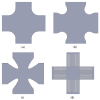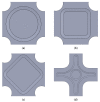Advances in Cruciform Biaxial Testing of Fibre-Reinforced Polymers
- PMID: 35215599
- PMCID: PMC8879799
- DOI: 10.3390/polym14040686
Advances in Cruciform Biaxial Testing of Fibre-Reinforced Polymers
Abstract
The heterogeneity and anisotropy of fibre-reinforced polymer matrix composites results in a highly complex mechanical response and failure under multiaxial loading states. Among the different biaxial testing techniques, tests with cruciform specimens have been a preferred option, although nowadays, they continue to raise a lack of consensus. It is therefore necessary to review the state of the art of this testing methodology applied to fibre-reinforced polymers. In this context, aspects such as the specific constituents, the geometric design of the specimen or the application of different tensile/compressive load ratios must be analysed in detail before being able to establish a suitable testing procedure. In addition, the most significant results obtained in terms of the analytical, numerical and experimental analyses of the biaxial tests with cruciform specimens are collected. Finally, significant modifications proposed in literature are detailed, which can lead to variants or adaptations of the tests with cruciform specimens, increasing their scope.
Keywords: biaxial loading; cruciform specimen; failure theories; fibre-reinforced polymer; finite element method; multiaxial; tensile/compressive loading; testing facility.
Conflict of interest statement
The authors declare no conflict of interest.
Figures





Similar articles
-
Determination of Interlaminar Shear Properties of Fibre-Reinforced Composites under Biaxial Loading: A New Experimental Approach.Polymers (Basel). 2022 Jun 24;14(13):2575. doi: 10.3390/polym14132575. Polymers (Basel). 2022. PMID: 35808621 Free PMC article.
-
Investigation of Biaxial Properties of CFRP with the Novel-Designed Cruciform Specimens.Materials (Basel). 2022 Oct 10;15(19):7034. doi: 10.3390/ma15197034. Materials (Basel). 2022. PMID: 36234375 Free PMC article.
-
Biaxial tension of fibrous tissue: using finite element methods to address experimental challenges arising from boundary conditions and anisotropy.J Biomech Eng. 2013 Feb;135(2):021004. doi: 10.1115/1.4023503. J Biomech Eng. 2013. PMID: 23445049 Free PMC article.
-
3D Printing of Fibre-Reinforced Thermoplastic Composites Using Fused Filament Fabrication-A Review.Polymers (Basel). 2020 Sep 24;12(10):2188. doi: 10.3390/polym12102188. Polymers (Basel). 2020. PMID: 32987905 Free PMC article. Review.
-
Perspective for Fibre-Hybrid Composites in Wind Energy Applications.Materials (Basel). 2017 Nov 8;10(11):1281. doi: 10.3390/ma10111281. Materials (Basel). 2017. PMID: 29117126 Free PMC article. Review.
Cited by
-
Determination of Interlaminar Shear Properties of Fibre-Reinforced Composites under Biaxial Loading: A New Experimental Approach.Polymers (Basel). 2022 Jun 24;14(13):2575. doi: 10.3390/polym14132575. Polymers (Basel). 2022. PMID: 35808621 Free PMC article.
References
-
- Kaddour A.S., Hinton M.J. Failure Criteria for Composites. Volume 1. Elsevier Ltd.; Amsterdam, The Netherlands: 2017. pp. 573–600. - DOI
-
- Hinton M.J., Soden P.D. Predicting failure in composite laminates: The background to the exercise. Compos. Sci. Technol. 1998;58:1001–1010. doi: 10.1016/S0266-3538(98)00074-8. - DOI
-
- Hinton M.J., Kaddour A.S., Soden P.D. Evaluation of failure prediction in composite laminates: Background to “part B” of the exercise. Compos. Sci. Technol. 2002;62:1481–1488. doi: 10.1016/S0266-3538(02)00094-5. - DOI
-
- Soden P.D., Hinton M.J., Kaddour A.S. Biaxial test results for strength and deformation of a range of E-glass and carbon fibre reinforced composite laminates. Failure exercise benchmark data. Fail. Criteria Fibre-Reinf. Polym. Compos. 2004;62:52–96. doi: 10.1016/S0266-3538(02)00093-3. - DOI
-
- Soden P.D., Kaddour A.S., Hinton M.J. Recommendations for designers and researchers resulting from the world-wide failure exercise. Compos. Sci. Technol. 2004;64:1223–1251. doi: 10.1016/S0266-3538(03)00228-8. - DOI
Publication types
Grants and funding
LinkOut - more resources
Full Text Sources

